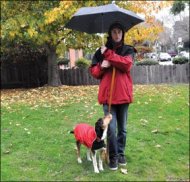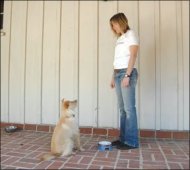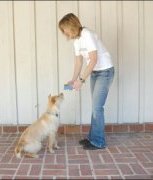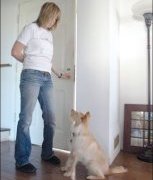Train dog stay

"STAY" CUE OVERVIEW
- Teach your dog to "Wait" and use the behavior consistently as part of your "say please" program (sit and wait for your food bowl), and to keep your dog safe (wait at doorways and getting out of cars).
- Teach your dog to "Stay" and use the behavior when you need to park your dog more solidly (for photo portraits, training class, obedience competition), when you need her to stay in position for a discrete period.
- Practice frequently, in short sessions. Set up the exercise so it's easy for her to succeed. "Wait" and "stay" should indicate that your dog has an opportunity to earn something rewarding.
Recently, I was struck by the realization that while “Wait!” is one of the most valuable cues I use with my dogs, it’s a behavior we didn’t usually teach in old-fashioned choke-chain obedience classes. Oh, we taught rock-solid obedience ring “Stays.” Some trainers substituted the word “wait” for “stay” to differentiate between recalls (“wait” means you’re going to get up and come to me when I call you) and the one-minute and three-minute sit-and-down-stays (stay means you are never to move no matter what happens until I come back to release you). Generally, though, we didn’t use “Wait” to mean “pause” as many of us dog owners do today. “Wait” is a valuable cue; I’d be lost without it.
Of course, a cue takes on whatever meaning you give to it when you teach your dog a new word or hand signal. We tend to use words that are meaningful to us (they are much easier to remember!) but if you wanted, you could teach your dog that “Banana!” means sit, “Orange” means down, “Pumpkin” means stay, and “Kiwi” means wait. As long as you teach your dog what behavior you want him to associate with your words and use them consistently, your dog will learn the meaning you’ve assigned to them and the cues will work for you.
Start with your dog in a sit. Hold a food bowl in front of your chest and say "Wait!" Pat Miller suggests that this exercise works better if the dog is positioned perpendicular to you, rather than sitting in front on you.
 Given that most trainers are well aware of this, it might surprise you to discover the intensity with which trainers sometimes debate the meaning of the cues “wait” and “stay.” The whole debate is silly; our cues mean whatever we teach our dogs they mean. I’ll explain how I use (and train) the wait and stay cues. Regardless of the words you choose to use and how you choose to use them, I hope you’ll discover the immense value of distinguishing between the wait and stay behaviors.
Given that most trainers are well aware of this, it might surprise you to discover the intensity with which trainers sometimes debate the meaning of the cues “wait” and “stay.” The whole debate is silly; our cues mean whatever we teach our dogs they mean. I’ll explain how I use (and train) the wait and stay cues. Regardless of the words you choose to use and how you choose to use them, I hope you’ll discover the immense value of distinguishing between the wait and stay behaviors.
Cueing "Wait" and "Stay"
I teach that “Wait!” means pause. If I’m leaving the house, I have my dogs sit and wait at the door as I leave. No door darters here! They know that as soon as the door closes they are free to run around the house doing acceptable doggie things. Mostly they go lie down, after a few barks from Lucy the Corgi and Missy the Aussie, who are both routinely a little stressed about being left behind. I teach that “Stay!” means “stay in the exact position I left you in until I return to your side and release you” – the standard obedience competition-style stay.
I use “wait” everywhere. I hardly ever use “stay.” If some, but not all, of our dogs are coming with me, I might ask two to wait while I invite the other two to move through the door. (Body blocking is useful for this maneuver.) All my dogs sit and wait for their food bowls – an excellent good manners behavior and an important part of a “say please” program. This reminds them that it’s my food – the leader controls all the good stuff – and I’m sharing it with them out of the goodness of my benevolent-leader heart.


Related posts:

 MARY ISENHOUR-LONG Owner - Trainer Photo by Stewart Event Images About The Trainer The phrase, “gone to the dogs”, is certainly an appropriate one to describe my…
MARY ISENHOUR-LONG Owner - Trainer Photo by Stewart Event Images About The Trainer The phrase, “gone to the dogs”, is certainly an appropriate one to describe my… 6 Principles of Successful Training 1. Be Consistent: Apply the same rules and the same words all the time. 2. Be Concise: Give your command just once. Repetition…
6 Principles of Successful Training 1. Be Consistent: Apply the same rules and the same words all the time. 2. Be Concise: Give your command just once. Repetition… Cesar Millan Cesar is a best-selling author, public speaker, and internationally acclaimed star of the TV shows “Dog Whisperer with Cesar Millan, ” “Leader of the…
Cesar Millan Cesar is a best-selling author, public speaker, and internationally acclaimed star of the TV shows “Dog Whisperer with Cesar Millan, ” “Leader of the… At Monument Dog Training, we believe that change is always possible . We regularly resolve aggressive behavioral issues, even with dogs who have been written off…
At Monument Dog Training, we believe that change is always possible . We regularly resolve aggressive behavioral issues, even with dogs who have been written off… After years of working with thousands of dogs and their owners, I have seen that the key ingredient people are actually looking for is how to be the Pack Leader…
After years of working with thousands of dogs and their owners, I have seen that the key ingredient people are actually looking for is how to be the Pack Leader…